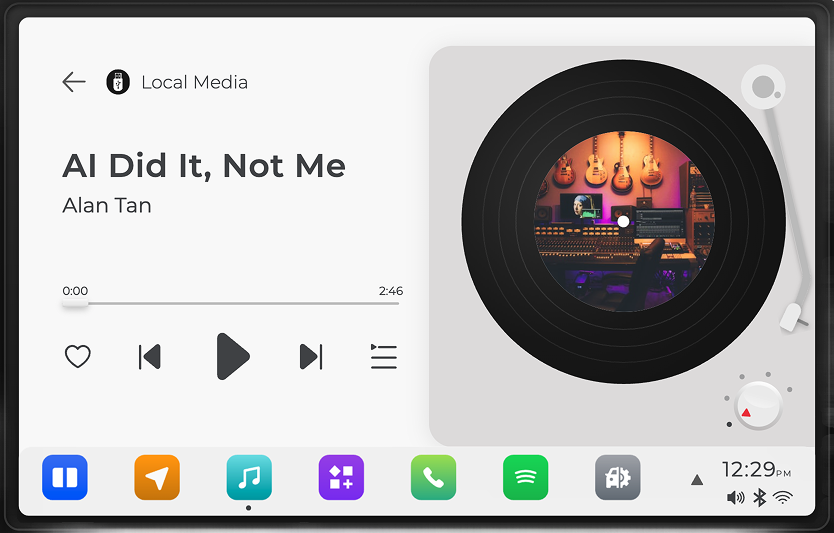These projects are a few examples of my work as a UX designer for companies like Telenav, Matterport, Motorola, and Razorfish.
From Canvas to Conversation: Designing for the Age of Agentic AI
Personal Exploration | 2025
Design is shifting from control to collaboration. Agentic Design explores how intelligent systems can think with us — not just respond to us. It’s about creating experiences that understand intent, adapt to context, and evolve over time. Instead of fixed interfaces, we design relationships between people and systems that learn, reason, and grow alongside their users.
Design In The Age of AI
Personal Exploration | 2025
I built a music player in Figma Make that simulates a turntable with a spinning record and moving tonearm. It streams demo tracks and plays user-uploaded MP3s. Creating a working prototype let me uncover real use cases and fix behavioral gaps that wouldn’t surface in static designs. It also showed how AI can streamline the traditional design-to-development process by letting designers test, validate, and refine experiences directly in near-production form.
Pushing the Limits of AI App Builders: AI-Assisted Prototype
Personal Exploration | 2025
I created a high-fidelity CarPlay-style infotainment prototype built entirely in Figma Make to test how far AI-assisted design-to-code workflows can go. What started as a quick experiment to run the Mapbox API evolved into a realistic functional system combining real-time navigation (MapLibre, OpenStreetMap, OSRM, Nominatim) and a voice AI assistant (Deepgram + OpenAI). The project highlights both the creative potential and technical fragility of current AI tools — capable of rapid integration and realistic functionality, yet prone to subtle logic errors, workflow instability, and the need for constant guidance.
Novo Ride
Telenav | 2022 - 2025
In this presentation, I discuss Novo Ride an in-car infotainment app focused on promoting safer driving. The app provides drivers with clear insights into their on-road behavior, including how often they hard brake, accelerate aggressively, or engage in high-speed driving. These factors are combined into an overall safety score, giving drivers a simple, meaningful way to understand and improve their driving habits.
In-Vehicle Voice Assistant
Telenav | 2020
In this presentation I review past in-vehicle voice recognition systems and how to build safer and more intuitive digital assistants for the next generation infotainment systems.
Button Placement Strategy for Navigation App
Telenav | 2018
In this presentation I discuss how cognitive psychology principals can be applied to Telenav’s reference navigation app in order to improve overall usability and ease of use of the product.
Tagging of Objects in Virtual Spaces
Matterport | 2015
This presentation was initially completed in order to define a strategy for how to integrate tags like web links, photos, videos into 3D virtual environments
Motorola Alert Mobile App
Motorola | 2014
Motorola Alert is an application to help you connect more quickly to family and friends when feeling unsafe or when in an emergency. When you put your phone in alert mode, it sends periodic notifications with your location to the people you designate so they can act fast to get you the help you need.
The app was designed to support value-tiered markets like Brazil and India where threats to personal safety and security are an every-day concern.
Sentience UX Project
Motorola | 2014
Motorola Assist detects your current activity and morphs the phone according to your needs during the activity. It can recognize when you shouldn’t be bothered, like when you’re sleeping or in a meeting. After hours, it only lets important calls through. It even knows when you’re driving and can automatically read out new text messages or play music. When you’re at home it can announce calls. You can set actions and exceptions so that they work exactly how you want them to based on your context.
Motorola Assist App
Motorola | 2014
Motorola Assist detects your current activity and morphs the phone according to your needs during the activity. It can recognize when you shouldn’t be bothered, like when you’re sleeping or in a meeting. After hours, it only lets important calls through. It even knows when you’re driving and can automatically read out new text messages or play music. When you’re at home it can announce calls. You can set actions and exceptions so that they work exactly how you want them to based on your context.
JCPenney.com Guided Navigation Menu System
Razorfish | 2010
Razorfish worked closely with JCPenney to create a guided navigation menu solution for their website. This was an extremely visible and important project for JCP since it would affect how users would ultimately browse and find most products on the site.











